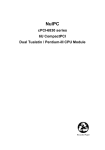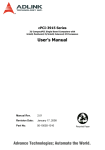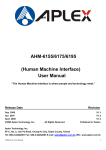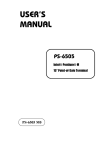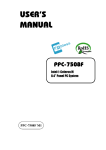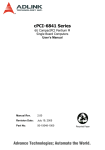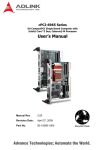Download Intel HS-2601A User's Manual
Transcript
HS-2601A Intel Low Power Mobile 500MHz Mini Board Computer •3.5” Size•All-in-One•CRT/Panel•LAN•WDT• •DOC•2 USB•IrDA•PC/104•Flash Disk• •PCI Bus Mini Board• C Cooppyyrriigghhtt D Diissccllaaiim meerrss The accuracy of contents in this manual has passed thorough checking and review before publishing. BOSER Technology Co., Ltd., the manufacturer and publisher, is not liable for any infringements of patents or other rights resulting from its use. The manufacturer will not be responsible for any direct, indirect, special, incidental or consequential damages arising from the use of this product or documentation, even if advised of the possibility of such damage(s). This manual is copyrighted and BOSER Technology Co., Ltd. reserves all documentation rights. Unauthorized reproduction, transmission, translation, and storage of any form and means (i.e., electronic, mechanical, photocopying, recording) of this document, in whole or partly, is prohibited, unless granted permission by BOSER Technology Co., Ltd. BOSER Technology Co., Ltd. reserves the right to change or improve the contents of this document without due notice. BOSER Technology Co., Ltd. assumes no responsibility for any errors or omissions that may appear in this manual, nor does it make any commitment to update the information contained herein. TTrraaddeem maarrkkss BOSER is a registered trademark of BOSER Technology Co., Ltd. ISB is a registered trademark of BOSER Technology Co., Ltd. Intel is a registered trademark of Intel Corporation. Award is a registered trademark of Award Software, Inc. All other trademarks, products and or product names mentioned herein are mentioned for identification purposes only, and may be trademarks and/or registered trademarks of their respective companies or owners. © Copyright 2002 BOSER Technology Co., Ltd. All Rights Reserved. Edition 1.2, June 28, 2003 Table of Contents Chapter 1 General Description ---------------------------------6 1.1 Major Features ------------------------------------------------------ 2 1.2 Specifications ------------------------------------------------------- 3 1.3 Board Dimensions ------------------------------------------------- 4 Chapter 2 Unpacking ---------------------------------------------5 2.1 Opening the Delivery Package --------------------------------- 5 2.2 Inspection------------------------------------------------------------- 5 Chapter 3 Hardware Installation-------------------------------7 3.1 3.2 3.3 3.4 3.5 3.6 3.7 Before Installation-------------------------------------------------- 7 Board Layout -------------------------------------------------------- 8 Jumper List----------------------------------------------------------- 9 Connector List ------------------------------------------------------ 9 Configuring the CPU ---------------------------------------------- 9 System Memory--------------------------------------------------- 10 DiskOnChip Address Setting ------------------------------ 10 3.7.1 Installing DiskOnChip Modules------------------------------- 10 3.7.1 Removing DiskOnChip Modules -------------------------------11 3.8 VGA Controller ---------------------------------------------------- 12 JP2: Panel Voltage Select--------------------------12 CN6: 15-pin CRT Connector (DB15) ---------------12 CN10: 50-pin Panel Connector --------------------13 3.9 IDE Drive Connector--------------------------------------------- 14 CN12: Primary IDE Connector ---------------------14 3.10 Floppy Disk Drive Connector--------------------------------- 15 CN11: FDD Connector ------------------------------15 3.11 Serial Port Connectors ----------------------------------------- 16 CN15 and CN14: COM1/COM2 Connector (5x2 Header) ----------------------------------------16 3.12 Parallel Connector ----------------------------------------------- 16 CN16: Parallel Connector --------------------------16 3.13 Ethernet Connector---------------------------------------------- 17 CN4: RJ-45 and LAN LED Connector --------------17 3.14 IrDA Connector --------------------------------------------------- 17 CN9: IrDA Connector -------------------------------17 3.15 USB Connector --------------------------------------------------- 18 CN13: USB Connector ------------------------------18 3.16 CMOS Data Clear ------------------------------------------------- 18 JP4: Clear CMOS------------------------------------18 3.17 Power Connectors ----------------------------------------------- 18 CN1: 4-pin Power Connector ----------------------18 CN5: 2-pin Power Input Connector----------------19 3.18 Keyboard/Mouse Connectors -------------------------------- 19 CN8: 6-pin Keyboard/Mouse Connector ---------19 CN7: PS/2 6-pin Mini DIN Keyboard/Mouse Connector-------------------------------------------19 3.19 System Front Panel Connectors ---------------------------- 19 LD2: IDE LED Connector ----------------------------19 LD1: Power LED --------------------------------------20 JP3: Reset Button Connector -----------------------20 3.20 Watchdog Timer -------------------------------------------------- 20 JP1: Watchdog Timer Active Type Setting -------20 3.21 CompactFlash Connector ----------------------------------- 22 3.22 Mini PCI Connector ---------------------------------------------- 23 PC1: Mini PCI Connector Pin Information ---------23 3.23 PC/104 Connectors ---------------------------------------------- 25 CN3: 40-pin PC/104 Expansion Slot ---------------25 CN2: 64-pin PC/104 Expansion Slot ---------------26 Chapter 4 Award BIOS Setup -------------------------------- 27 4.1 Starting Setup ----------------------------------------------------- 27 4.2 Using Setup -------------------------------------------------------- 28 4.2.1 Getting Help-----------------------------------------------------------28 4.3 Main Menu ---------------------------------------------------------- 29 4.4 Standard CMOS Setup------------------------------------------ 31 4.5 BIOS Features Setup -------------------------------------------- 34 4.6 Chipset Features Setup ---------------------------------------- 39 4.7 Power Management Setup ------------------------------------ 43 4.7.1 PM Timers -------------------------------------------------------------45 4.7.2 Reload Global Timer Events --------------------------------------46 4.8 PNP/PCI Configuration ----------------------------------------- 47 4.9 Load BIOS Defaults---------------------------------------------- 48 4.10 Load Setup Defaults--------------------------------------------- 49 4.11 Integrated Peripherals ------------------------------------------ 50 4.12 Supervisor/User Password Setting------------------------- 53 4.13 IDE HDD Auto Detection --------------------------------------- 54 4.14 Save & Exit Setup ------------------------------------------------ 55 4.15 Exit Without Saving---------------------------------------------- 56 Chapter 5 Software Utilities ----------------------------------- 57 5.1 VGA Driver Installation for Win 95/98---------------------- 57 5.2 VGA Driver Installation for Win NT4.0 --------------------- 59 5.3 LAN Driver Installation for WIN95 & WIN98-------------- 62 5.3.1 Win98-------------------------------------------------------------------62 5.3.2 Win95-------------------------------------------------------------------62 5.4 LAN Driver Installation for Win NT4.0 --------------------- 64 SSaaffeettyy IInnssttrruuccttiioonnss Integrated circuits on computer boards are sensitive to static electricity. To avoid damaging chips from electrostatic discharge, observe the following precautions: Do not remove boards or integrated circuits from their anti-static packaging until you are ready to install them. Before handling a board or integrated circuit, touch an unpainted portion of the system unit chassis for a few seconds. This helps to discharge any static electricity on your body. Wear a wrist-grounding strap, available from most electronic component stores, when handling boards and components. Fasten the ALLIGATOR clip of the strap to the end of the shielded wire lead from a grounded object. Please wear and connect the strap before handle the HS-2601A to ensure harmlessly discharge any static electricity through the strap. Please use an anti-static pad when putting down any components or parts or tools outside the computer. You may also use an anti-static bag instead of the pad. Please inquire from your local supplier for additional assistance in finding the necessary anti-static gadgets. NOTE: DO NOT TOUCH THE BOARD OR ANY OTHER SENSITIVE COMPONENTS WITHOUT ALL NECESSARY ANTI-STATIC ROTECTION. This page intentionally left blank. Chapter 1 General Description The HS-2601A is a 100MHz Intel® BX chipset-based Mini PCI Bus Intel Mobile board. With features such as enhanced I/O effects with CRT/VGA, and LAN all combined, the HS-2601A is an ideal all-in-one compact-size board for the demanding embedded applications and IA platforms. Its onboard DMA33 to IDE drive interface architecture allows the HS-2601A to support data transfers of 33MB/sec with a maximum of two IDE drives. Its Intel® BX chipset design makes it possible for the board to support most Intel Mobile microprocessors in the market, The C&T 69000 CRT/Panel display controller offers an on-chip 2MB memory that supports up to 1280x1024x256 colors display resolution. For suitable installation into any size system with 8/16/32bit ISA and/or PCI slots operation, the board’s advanced PISA bus add-on feature allows user to easily obtain both ISA's 16bit and PCI's 32bit full set signals from a half size PISA slot. System memory is also sufficient with the two DIMM sockets that can support up to 256MB. Additional onboard connectors include an advanced USB and IrDA ports providing faster data transmission, a DOS-compatible DiskOnChip socket with a maximum capacity of 288MB, and one external RJ45 connector for 10/100 Base-TX Ethernet use. 1 To ensure the reliability in an unmanned or standalone system, the Watchdog Timer (WDT) onboard HS-2601A is designed with pure hardware that does not need the arithmetical functions of a real-time clock chip. If any program causes unexpected halts to the system, the onboard Watchdog Timer (WDT) will automatically reset the CPU or generate an interrupt to resolve such condition. 1.1 Major Features The HS-2601A comes with the following features: BGA Packaged Intel Low Power Mobile CPU at 500MHz, 700MHz, and 800MHz One SO-DIMM socket with a maximum capacity of 256MB Fast PCI DMA33 controller supporting two IDE disk drives Mini PCI Local Bus support Two RS-232 serial ports PS/2 Keyboard and PS/2 Mouse connectors One enhanced bi-directional parallel port supporting SPP/ECP/EPP modes Winbond W83977 super I/O chipset C&T 69000 CRT/Panel display controller Intel 82559 100 Base-TX LAN controller DiskOnChip memory size up to 288MB PC/104 Bus connector Optional 8~64MB Flash Disk support 2 1.2 Specifications CPU: Intel Low Power Mobil CPU from 500-800 MHz Bus Interface: Mini PCI Local Bus Memory: One SO-DIMM socket supporting up to 256MB Chipset: Intel 82443BX I/O Chipset: Winbond W83977 VGA: C&T 69000 with 2MB memory supporting CRT/Panel displays up to 1280 x1024 at 256 colors IDE: Two IDE disk drives supporting ATA/33 and with a transfer rate up to 33MB/sec Flash Disk: 8~64 MB IDE interface Flash Disk support (optional) FDD: Supports up to two floppy disk drives Parallel: One enhanced bi-dirctional parallel port supporting SPP/ECP/EPP LAN: Intel 82559 100 Base-TX LAN Serial Port: Two RS-232 serial ports include 16C550 UART with 16byte FIFO IrDA: One IrDA TX/RX header USB: Two USB ports CompactFlash: One optional CompactFlash adapter slot on solder side Keyboard/Mouse: PS/2 6-pin Mini DIN or 6-pin connector DiskOnChip: Socket for DiskOnChip and memory size up to 288MB BIOS: Award PnP Flash BIOS Watchdog Timer: Sets 1, 2, 10, 20, 110, 220 seconds activity trigger with Reset or NMI CMOS: Battery backup DMA Channels: 7 Interrupt Levels: 15 PC/104: PC/104 connector for 16bit ISA Bus Main Power: Single +5V power input Extra Power: One 4-pin +12V/-12V connector Max. Power Consumption: +5V@6A o Operating Temperature: 0~60 C Board Size: 10.3 x 14.6 cm 3 1.3 4 Board Dimensions Chapter 2 Unpacking 2.1 Opening the Delivery Package The HS-2601A is packed in an anti-static bag. The board has components that are easily damaged by static electricity. Do not remove the anti-static wrapping until proper precautions have been taken. Safety Instructions in front of this manual describe anti-static precautions and procedures. 2.2 Inspection After unpacking the board, place it on a raised surface and carefully inspect the board for any damage that might have occurred during shipment. Ground the board and exercise extreme care to prevent damage to the board from static electricity. Integrated circuits will sometimes come out of their sockets during shipment. Examine all integrated circuits, particularly the BIOS, processor, memory modules, ROM-Disk, and keyboard controller chip to ensure that they are firmly seated. The HS-2601A delivery package contains the following items: HS-2601A Industrial Single Board Printer Ports Flat Cable x 1 COM port Flat Cable x 1 IDE port Flat Cable x 1 FDD port Flat Cable x 1 PS/2 Keyboard/Mouse Transfer Cable x 1 Utility Disc User’s Manual 5 It is recommended that you keep all the parts of the delivery package intact and store them in a safe/dry place for any unforeseen event requiring the return shipment of the product. In case you discover any missing and/or damaged items from the list of items, please contact your dealer immediately. 6 Chapter 3 Hardware Installation This chapter provides the information on how to install the hardware using the HS-2601A. This chapter also contains information related to jumper settings of switch, watchdog timer, and the DiskOnChip address selection etc. 3.1 Before Installation After confirming your package contents, you are now ready to install your hardware. The following are important reminders and steps to take before you begin with your installation process. 1. Make sure that all jumper settings match their default settings and CMOS setup correctly. Refer to the sections on this chapter for the default settings of each jumper. 2. Go through the connections of all external devices and make sure that they are installed properly and configured correctly within the CMOS setup. Refer to the sections on this chapter for the detailed information on the connectors. 3. Keep the manual and diskette in good condition for future reference and use. 7 3.2 8 Board Layout 3.3 Jumper List Jumper JP1 JP2 JP4 3.4 Definition Watchdog Timer Active Type Select Panel Voltage Select Clear CMOS Default Page Short 2-3 Short 1-2 Short 1-2 20 12 18 Connector List Connector Definition Page JP3 CN1 CN2 CN3 CN4 CN5 CN6 CN7 CN8 CN9 CN10 CN11 CN12 CN13 CN14 CN15 CN16 CN17 LD1 LD2 PC1 U2 U7 Reset Button 4-pin Power In Connector PC/104 64-pin Connector PC104 40-pin Connector RJ45 and LAN LED Connector 2-pin Power In Connector CRT Connector PS/2 6-pin Mini Din KB/Mouse Connector 6-pin Keyboard/Mouse Connector IrDA Connector Panel Connector Floppy Connector IDE Connector USB Connector COM2 Connector (5x2 Header) COM1 Connector (5x2 Header) Parallel Connector CompactFlash Connector Power LED Connector HDD LED Connector Mini PCI Connector SO-DIMM Socket DiskOnChip Socket 20 18 26 25 17 18 12 19 19 17 13 15 14 18 16 16 16 22 19 19 23 10 10 3.5 Configuring the CPU The HS-2601A, with its onboard BGA processor, auto-detects the features of the mounted microprocessor onboard. The HS-2601A automatically identifies the frequency and clock speed of the installed microprocessor chip, thereby eliminating the need for user to do additional CPU configuration or hardware settings related to it. 9 3.6 System Memory The HS-2601A provides one SO-DIMM socket at location U2. This onboard memory socket can support 64MB, 128MB and 256MB SO-DIMM modules. The system’s maximum memory capacity is 256MB. 143 1 144 2 144-pin SO-DIMM Socket pin orientation NOTE: 3.7 SO-DIMM sockets out on the market these days have very fragile contacts that attach to modules. We highly recommend you not to regularly remove the installed SO-DIMM from its socket. Doing so may wear out the contact between the socket and module. DiskOnChip Address Setting The DiskOnChip function allows the system to boot or operate without a FDD or a HDD. DiskOnChip modules may be formatted as drive C or A. With DiskOnChip, user may also execute DOS commands such as FORMAT, SYS, COPY, XCOPY, DISCOPY and DISKCOMP etc. The U7 location onboard the HS-2601A is the DiskOnChip module socket. The board circuitry assigns a LOCKED starting memory address of the installed module at D000. If you have another memory device that has a similar memory capacity with that of the DOC in your system, please set both at different memory address mapping to avoid the mapping area conflicts. Failing to do so will not make the HS-2601A and the additional memory device function properly. 3.7.1 Installing DiskOnChip Modules When installing a DiskOnChip module onto your board, please take note of the following: 1. Orient yourself properly with the location of the DiskOnChip socket. Try to locate the pin 1 location on your socket. Pin numbers are usually printed on either the component side or the solder side of your board. 2. Locate the Pin 1 location on your DiskOnChip module. More often than not, Pin 1 can be found on the lower right corner of the chip. Please refer to the diagram for the exact location. 10 3. Once you have figured out where the pin 1 locations are on both chip and socket, align the module’s pins on an upright angle against the socket. Using both thumbs, gently press the module into the socket until all the pins are secured to their designations. Disk OnC hip Pin 1 Location 4. The installation is now complete and your module is now ready for use. NOTE: If you encounter difficulty installing your DiskOnChip module, please consult a qualified technician or engineer to perform the installation. 3.7.1 Removing DiskOnChip Modules When removing a DiskOnChip module from its socket, please take note of the following: 1. Loosen the contact of the module from its socket using a screwdriver. 2. Insert the screwdriver’s flat head into a gap on either end of the socket. Do not insert the screwdriver head on either side where the pins are located. Doing so might damage the pins in the process. 3. Slowly lift the screwdriver handle upwards. This will disengage the module from its socket. NOTE: If you encounter difficulty removing your DiskOnChip module, please consult a qualified technician or engineer to remove it for you. 11 3.8 VGA Controller The HS-2601A has an onboard jumper that selects the working voltage of the flat panel connected to the system. Jumper JP2 offers two voltage settings for the user. JP2: Panel Voltage Select Options Settings 5.0 V (default) 3.3 V Short 1-2 Short 2-3 3 2 1 WARNING: Please contact the supplier of your panel and make sure of the correct voltage it uses. Incorrect settings on JP8 may cause internal damage to your panel. The built-in C&T 69000 CRT/Panel display controller, onboard HS-2601A, uses 2MB memory to support resolutions up to 1280x1024x256 colors. The HS-2601A provides two connection methods of a VGA device. CN20 offers a single standard CRT connector (DB15) while CN16 is the 50-pin panel connector onboard reserved for flat panel installation. CN6: 15-pin CRT Connector (DB15) PIN Description PIN Description 1 3 5 7 9 11 13 15 Red Blue GND GND N/C N/C HSYNC GND 2 4 6 8 10 12 14 Green N/C GND GND GND GND VSYNC 1 5 10 15 12 6 11 CN10: 50-pin Panel Connector PIN. Description PIN Description 1 3 5 7 9 11 13 15 17 19 21 23 25 27 29 31 33 35 37 39 41 43 45 47 49 +12V GND Note 3.3V / 5V ENAVEE P0 P2 P4 P6 P8 P10 P12 P14 P16 P18 P20 P22 P24 SHFCLK M GND P26 P28 P30 P32 P34 2 4 6 8 10 12 14 16 18 20 22 24 26 28 30 32 34 36 38 40 42 44 46 48 50 +12V GND ENAVDD GND P1 P3 P5 P7 P9 P11 P13 P15 P17 P19 P21 P23 P25 FLM LP ENABKL P27 P29 P31 P33 P35 47 45 43 41 39 37 35 33 31 29 27 25 23 21 19 17 15 13 11 9 7 5 3 49 1 50 2 48 46 44 42 40 38 36 34 32 30 28 26 24 22 20 18 16 14 12 10 8 NOTE: 6 4 Please set the proper voltage of your panel using JP8 before proceeding on installing it. 13 3.9 IDE Drive Connector CN12, a 44-pin connector, provides the PCI E-IDE drive provisions onboard. A maximum of four IDE drives may be connected on them. CN12: Primary IDE Connector CN15 Description CN15 Description 1 3 5 7 9 11 13 15 17 19 21 23 25 27 29 31 33 35 37 39 41 43 BRSTDRVJ DD7-1 DD6-1 DD5-1 DD4-1 DD3-1 DD2-1 DD1-1 DD0-1 GND RPDDREQRPDIOWRPDIORPIORDY RPDACKIRQ14 RPDA1RPDA0RPCS1HLED VCC GND 2 4 6 8 10 12 14 16 18 20 22 24 26 28 30 32 34 36 38 40 42 44 GND DD8-1 DD9-1 DD10-1 DD11-1 DD12-1 DD13-1 DD14-1 DD15-1 N/C GND GND GND PRIPD1GND N/C N/C RPDA2RPCS3GND VCC VCC 44 42 40 38 36 34 32 30 28 26 24 22 20 18 16 14 12 10 8 6 4 2 1 43 41 39 37 35 33 31 29 27 25 23 21 19 17 15 13 11 9 14 7 5 3 3.10 Floppy Disk Drive Connector The HS-2601A uses a standard 34-pin header connector, CN11, for floppy disk drive connection. A total of two FDD drives may be connected to CN11 at any given time. CN11: FDD Connector PIN Description PIN Description 1 3 5 7 9 11 13 15 17 19 21 23 25 27 29 31 33 GND GND GND GND GND GND GND GND GND GND GND GND GND GND N/C GND N/C 2 4 6 8 10 12 14 16 18 20 22 24 26 28 30 32 34 RWCN/C DS1Index# Motor Enable A# Drive Select B# Drive Select A# Motor Enable B# Direction# Step# WDWETrack 0# WPRDATAHEADDSKCHGGND 1 2 34 u GND GND GND GND GND GND GND GND GND GND GND GND GND N/C N/C GND 33 RWC- N/C DS1- INDEX# MOTOR ENABLE A# DRIVE SELECT B# DRIVE SELECT A# MOTOR ENABLE B# DIRECTION# STEP# WD’ WE- TRACK 0# WP- RDATA- HEAD- DSKCHG- 15 3.11 Serial Port Connectors The HS-2601A offers two NS16C550 compatible UARTs with Read/Receive 16byte FIFO serial ports and two internal 10-pin headers. CN15 and CN14: COM1/COM2 Connector (5x2 Header) PIN Description PIN Description 1 3 5 7 9 DCD RXD TXD DTR GND 2 4 6 8 10 DSR RTX CTX RI N/C DSR 2 1 DCD RTX 4 3 RXD CTX 6 5 TXD RI 8 7 DTR N/C 10 9 GND CN14 and CN15 3.12 Parallel Connector CN16 is a standard 26-pin flat cable connector deigned to accommodate parallel port connection onboard the HS-2601A. CN16: Parallel Connector 16 PIN Description PIN Description 1 3 5 7 9 11 13 15 17 19 21 23 25 STBJ PD1 PD3 PD5 PD7 BUSY SLCT ERRJ SLINJ GND GND GND GND 2 4 6 8 10 12 14 16 18 20 22 24 26 PD0 PD2 PD4 PD6 ACKJ PE AFDJ INITJ GND GND GND GND GND STBJ PD1 PD3 PD5 PD7 BUSY SLCT ERRJ SUNJ GND GND GND GND 25 1 26 2 PD0 PD2 PD4 PD6 ACKJ PE AFDJ INITJ GND GND GND GND GND 3.13 Ethernet Connector The HS-2601A provides one external RJ-45 10/100 Base-TX LAN interface connector. Please refer to the following detail of pin information. No Use TX+ TXRX+ No Use No Use RXNo Use No Use GND RX- Description 1 2 3 4 5 6 7 8 9 TX- PIN No Use CN4: RJ-45 and LAN LED Connector 2 8 1 No Use No Use RX+ TX+ 7 Aside from the RJ-45 provision onboard the HS-2601A, the board also features an LED indicator that displays the 10T speed running, 100T speed running, and active status of the LAN connection. 3.14 IrDA Connector CN9 is a 5-pin internal IR communication connector for connection of an IrDA device. CN9: IrDA Connector PIN Description 1 2 3 4 5 VCC FIRRX IRRX GND IRTX VCC 1 N/C 2 IRRX 3 VCC 4 IRTX 5 17 3.15 USB Connector The HS-2601A provides one 8-pin connector for USB0 & USB1 port connections at location CN13. GND BD1+ 2 8 1 7 GND VCC BD1BD1+ GND BD0+ Description 2 4 6 8 BD0- PIN VCC BD0BD0+ GND VCC Description 1 3 5 7 VCC PIN BD1- CN13: USB Connector 3.16 CMOS Data Clear The HS-2601A has a Clear CMOS jumper on JP4. The JP4 settings below apply to the standard HS-2601A using a battery backed up CMOS chip. JP4: Clear CMOS Options Settings Normal Operation * Clear CMOS Short 1-2 Short 2-3 IMPORTANT: 1 2 3 The default setting of JP4 is Short 2-3. Before you turn on the power of your system, please set JP4 to Short 1-2 for normal operation. 3.17 Power Connectors HS-2601A provides one 4-pin power connector at CN1 and a single 2-pin power connector at CN5. CN1: 4-pin Power Connector 18 PIN Description 1 2 3 4 VCC GND GND +12V 1 VCC GND GND +12V 4 CN5: 2-pin Power Input Connector PIN Description 1 2 +5V GND 1 2 3.18 Keyboard/Mouse Connectors The HS-2601A offers two possibilities for keyboard connections. The connections are via CN7 for an external PS/2 type keyboard/mouse or via CN8 for an internal 5-pin cable converter to an AT keyboard. CN8: 6-pin Keyboard/Mouse Connector PIN Description 1 2 3 4 5 6 Keyboard Clock Keyboard Data Mouse Data GND VCC Mouse Clock CN7: PS/2 6-pin Mini DIN Keyboard/Mouse Connector PIN Description 1 2 3 4 5 6 Keyboard Data Mouse Data GND VCC Keyboard Clock Mouse Clock 3.19 System Front Panel Connectors The HS-2601A has one LED at location LD1 that indicates the power-on status. This visual feature of the IDE LED may also be connected to an external IDE LED via connector LD2. Description 1 2 +5V HDD ACTIVE# 1 2 HDD Active$ PIN +5V LD2: IDE LED Connector 19 LD1 and JP3 are the Keylock and Reset Button connectors onboard. LD1: Power LED PIN Description 1 2 +5V GND 2 1 Description 1 2 GND External Reset 1 2 Ext. Reset PIN GND JP3: Reset Button Connector 3.20 Watchdog Timer There are three access cycles of Watch-Dog Timer as Enable, Refresh and Disable are the three access cycles of Watchdog Timer. The Enable cycle proceeds via READ PORT 443H whereas the Disable cycle proceeds via READ PORT 045H. A continued Enable cycle after a first Enable cycle means Refresh. Once the Enable cycle is active, a Refresh cycle is requested before the time-out period. This restarts counting of the WDT period. When the time counting goes over the period preset of WDT, it will assume that the program operation is abnormal. A System Reset signal to re-start or a NMI cycle to the CPU transpires when such error happens. Jumper JP1 is used to select the function of Watchdog Timer. JP1: Watchdog Timer Active Type Setting Options Settings Active NMI System Reset (default) Disabled Watchdog Timer Short 1-2 Short 2-3 Open 3 2 1 The Watchdog Timer is disabled after the system Power-On. It can be enabled via an Enable cycle and reading the control port (443H), or via a Refresh cycle and reading the control port (443H), or via a Disable cycle and reading the disable control port (045H). 20 After an Enable cycle of WDT, user must immediately execute a Refresh cycle to WDT before its period setting comes to an end every 1, 2, 10, 20, 110 or 220 seconds. If the Refresh cycle does not activate before WDT period cycle, the onboard WDT architecture will issue a Reset or NMI cycle to the system. There are three I/O ports that control the Watchdog Timer. 443H 443H 045H I/O Read I/O Read I/O Read The Enable cycle The Refresh cycle The Disable cycle The following sample program shows how to Enable, Disable and Refresh the Watchdog Timer: WDT_EN_RF WDT_DIS EQU EQU 0433H 0045H WT_Enable PUSH PUSH MOV IN POP POP RET AX DX DX,WDT_EN_RF AL,DX DX AX ; keep AX DX PUSH PUSH MOV IN POP POP RET AX DX DX,WDT_ET_RF AL,DX DX AX ; keep AX, DX PUSH PUSH MOV IN POP POP RET AX DX DX,WDT_DIS AL,DX DX AX WT_Refresh WT_DISABLE ; enable the WDT ; get back AX, DX ; refresh the WDT ; get back AX, DX ; disable the WDT ; get back AX, DX 21 3.21 CompactFlash Connector Si de Fa Ma br de iq in ue J Au apa Ja n / po n Re ar CE CF C om pa ct Fl as hT M PC Si B de So Vi lde ew r The HS-2601A also offers an optional CompactFlash connector which is IDE interface located at the solder side of the board (beneath the SO-DIMM connector). The designated CN17 connector, once soldered with an adapter, can hold CompactFlash cards of various sizes. Please turn off the power before inserting the CF card. Inserting a CompactFlash card into the adapter is not a difficult task. The socket and card are both keyed and there is only one direction for the card to be completely inserted. Refer to the diagram below for the traditional way of inserting the card. 22 3.22 Mini PCI Connector HS-2601A supports a Mini PCI interface which is a very popular notebook computer expansion interface for Modem, Video, LAN, etc. The Mini PCI onboard HS-2601A is at location PC1 with pin definitions listed on the table below. PC1: Mini PCI Connector Pin Information PIN. Description PIN. Description 1 3 5 7 9 11 13 15 17 19 21 23 25 27 29 31 33 35 37 39 41 43 45 47 49 51 53 55 57 59 61 63 65 67 69 INTB# 3.3V RESERVED GND CLK GND REQ# 3.3V AD[31] AD[29] GND AD[27] AD[25] RESERVED C/BE[3]# AD[23] GND AD[21] AD[19] GND AD[17] C/BE[2]# IRDY# 3.3V CLKRUN# SERR# GND PERR# C/BE[1]# AD[14] GND AD[12] AD[10] GND AD[8] 2 4 6 8 10 12 14 16 18 20 22 24 26 28 30 32 34 36 38 40 42 44 46 48 50 52 54 56 58 60 62 64 66 68 70 5V D# RESERVED N.C. RST# 3.3V GNT# GND PME# RESERVED AD[30] 3.3V AD[28] AD[26] AD[24] IDSEL GND AD[22] AD[20] PAR AD[18] AD[16] GND FRAME# TRDY# STOP# 3.3V DEVSEL# GND AD[15] AD[13] AD[11] GND AD[9] C/BE[0]# . . . More on next page . . . 23 PIN. Description PIN. Description 71 73 75 77 79 81 83 85 87 89 91 93 95 97 99 AD[7] 3.3V AD[5] RESERVED AD[3] 5V AD[1] GND AC_SYNC AC_SDATA_IN AC_BIT_CLK AC_CODEC_ID1# MOD_AUDIO_MON AUDIO_GND SYS_AUDIO_OUT 72 74 76 78 80 82 84 86 88 90 92 94 96 98 100 3.3V AD[6] AD[4] AD[2] AD[0] RESERVED_WIP2 RESERVED_WIP2 GND M66EN AC_SDATA_OUT AC_CODEC_IDO# AC_RESET# RESERVED GND SYS_AUDIO_IN 2 1 24 100 Mini PCI Socket pin orientation 99 3.23 PC/104 Connectors The PC/104 expansion bus offers provisions to connect all types of PC/104 modules. With the PC/104 bus being known as the new generation of industrial embedded 16bit PC standard bus, thousands of PC/104 modules from multiple venders can be easily installed onboard. The detailed pin assignment of the PC/104 expansion bus connectors CN10 and CN11 are listed on the following tables: NOTE: The PC/104 connector allows direct plugging or stack-through piling of PC/104 modules without requiring the PC/104 mounting kit. CN3: 40-pin PC/104 Expansion Slot PIN 1 2 3 4 5 6 7 8 9 10 11 12 13 14 15 16 17 18 19 20 Description PIN Description GND MEMCS16* IOSC16* IRQ10 IRQ11 IRQ12 IRQ15 IRQ14 DACK0* DRQ0 DACK5* DRQ5 DACK6* DRQ6 DACK7* DRQ7 +5V MASTER* GND GND 21 22 23 24 25 26 27 28 29 30 31 32 33 34 35 36 37 38 39 40 GND SBHE* LA23 LA22 LA21 LA20 LA19 LA18 LA17 MEMR* MEMW* SD8 SD9 SD10 SD11 SD12 SD13 SD14 SD15 N/C 1 21 20 40 25 CN2: 64-pin PC/104 Expansion Slot PIN 1 2 3 4 5 6 7 8 9 10 11 12 13 14 15 16 17 18 19 20 21 22 23 24 25 26 27 28 29 30 31 32 26 Description PIN Description IOCHECK* SD7 SD6 SD5 SD4 SD3 SD2 SD1 SD0 IOCHRDY AEN SA19 SA18 SA17 SA16 SA15 SA14 SA13 SA12 SA11 SA10 SA9 SA8 SA7 SA6 SA5 SA4 SA3 SA2 SA1 SA0 GND 33 34 35 36 37 38 39 40 41 42 43 44 45 46 47 48 49 50 51 52 53 54 55 56 57 58 59 60 61 62 63 64 GND RESETDRV +5V IRQ9 -5V DRQ2 -12V NOW* +12V GND SMEMW* SMEMR* IOW* IOR* DACK3* DRQ3 DACK1* DRQ1 REFRESH* SYSCLK IRQ7 IRQ6 IRQ5 IRQ4 IRQ3 DACK2* TC BALE +5V OSC GND GND 1 33 32 64 Chapter 4 Award BIOS Setup The HS-2601A uses Award PCI/ISA BIOS for the system configuration. The Award BIOS setup program is designed to provide the maximum flexibility in configuring the system by offering various options that could be selected for end-user requirements. This chapter is written to assist you in the proper usage of these features. 4.1 Starting Setup The Award BIOS is immediately activated when you first power on the computer. The BIOS reads the system information contained in the CMOS and begins the process of checking out the system and configuring it. When it finishes, the BIOS will seek an operating system on one of the disks and then launch and turn control over to the operating system. While the BIOS is in control, the Setup program can be activated in one of two ways: 1. By pressing <Del> immediately after switching the system on, or 2. By pressing the <Del> key when the following message appears briefly at the bottom of the screen during the POST (Power On Self Test). Press DEL to enter SETUP. If the message disappears before you respond and you still wish to enter Setup, restart the system to try again by turning it OFF then ON or pressing the "RESET" button on the system case. You may also restart by simultaneously pressing <Ctrl>, <Alt>, and <Delete> keys. If you do not press the keys at the correct time and the system does not boot, an error message will be displayed and you will again be asked to... PRESS F1 TO CONTINUE, DEL TO ENTER SETUP 27 4.2 Using Setup In general, you use the arrow keys to highlight items, press <Enter> to select, use the <PageUp> and <PageDown> keys to change entries, press <F1> for help and press <Esc> to quit. The following table provides more detail about how to navigate in the Setup program using the keyboard. Up arrow Down arrow Left arrow Right arrow Esc key PgUp key PgDn key + key - key F1 key (Shift)F2 key F3 key F4 key F5 key F6 key F7 key F8 key F9 key F10 key Move to previous item Move to next item Move to the item in the left hand Move to the item in the right hand Main Menu -- Quit and not save changes into CMOS Status Page Setup Menu and Option Page Setup Menu -Exit current page and return to Main Menu Increase the numeric value or make changes Decrease the numeric value or make changes Increase the numeric value or make changes Decrease the numeric value or make changes General help, only for Status Page Setup Menu and Option Page Setup Menu Change color from total 16 colors. F2 to select color forward, (Shift) F2 to select color backward Calendar, only for Status Page Setup Menu Reserved Restore the previous CMOS value from CMOS, only for Option Page Setup Menu Load the default CMOS value from BIOS default table, only for Option Page Setup Menu Load the default Reserved Reserved Save all the CMOS changes, only for Main Menu 4.2.1 Getting Help Press F1 to pop up a small help window that describes the appropriate keys to use and the possible selections for the highlighted item. To exit the Help Window press <Esc> or the F1 key again. 28 4.3 Main Menu Once you enter the Award BIOS CMOS Setup Utility, the Main Menu will appear on the screen. The Main Menu allows you to select from several setup functions and two exit choices. Use the arrow keys to select among the items and press <Enter> to enter the sub-menu. ROM PCI/ISA BIOS (2A69KD2L) CMOS SETUP UTILITY AWARD SOFTWARE, INC. STANDARD CMOS SETUP INTEGRATED PERIPHERALS BIOS FEATURES SETUP SUPERVISOR PASSWORD CHIPSET FEATURES SETUP USER PASSWORD POWER MANGEMENT SETUP IDE HDD AUTO DETECTION PNP/PCI CONFIGURATION SAVE & EXIT SETUP LOAD BIOS DEFAULTS EXIT WITHOUT SAVING LOAD SETUP DEFAULTS Esc:Quit F10:Save & Exit NOTE: :Select Item (Shift)F2:Change Color A brief description of the highlighted choice appears at the bottom of the screen. Standard CMOS Setup This setup page includes all the items in a standard, AT-compatible BIOS. BIOS Features Setup This setup page includes all the items of Award special enhanced features. Chipset Features Setup This setup page includes all the items of chipset special features. Power Management Setup This entry only appears if your system supports Power Management, “Green PC”, standards. PNP/PCI Configuration Setup This entry appears if your system supports PNP/PCI. Load BIOS Defaults The BIOS defaults have been set by the manufacturer and represent settings that provide the minimum requirements for your system to operate. 29 Load Setup Defaults The chipset defaults are settings that provide for maximum system performance. While Award has designed the custom BIOS to maximize performance, the manufacturer has the right to change these defaults to meet their needs. Integrated Peripherals This section page includes all the items of IDE hard drive and Programmed Input / Output features. Set Supervisor / User Password Change, set, or disable password. It allows you to limit access to the system and Setup, or just to Setup. IDE HDD Auto Detection Automatically detect and configure hard disk parameters. The Award BIOS includes this ability in the event you are uncertain of your hard disk’s parameters. Save & Exit Setup Save CMOS value changes to CMOS and exit setup. Exit Without Saving Abandon all CMOS value changes and exit setup. 30 4.4 Standard CMOS Setup The Standard Setup is used for the basic hardware system configuration. The main function is for Data/Time and Floppy/Hard Disk Drive settings. Please refer to the following screen for the setup. When the IDE hard disk drive you are using is larger than 528MB, you must set the HDD mode to LBA mode. Please use the IDE Setup Utility in BIOS SETUP to install the HDD correctly. ROM PCI/ISA BIOS (2A69KD2L) STANDARD CMOS SETUP AWARD SOFTWARE, INC. Data (mm:dd:yy) : Fri, Dec 19 1998 Time (hh:mm:ss) : 00:00:00 TYPE SIZE CYLS HEAD PRECOMP LANDZ SECTOR : Primary Master Primary Slave Secondary Master Secondary Slave : : 0 0 0 0 0 0 0 0 0 0 0 0 Base Extended Memory Memory : 640K 15360K Other Total Memory Memory : : 384K 16384K MODE CHS CHS : Drive A : 1.44M , 3.5 in. Drive B : None LCD&CRT : Auto Halt On : All, But Keyboard ESC : Quit F1 : Help 0 0 : Select Item (Shift) F2: Change Color : PU/PD/ + / - : Modify Date: The date format is <day>, <date> <month> <year>. Press <F3> to show the calendar. day date month year The day, from Sun to Sat, determined by the BIOS and is display-only The date, from 1 to 31 (or the maximum allowed in the month) The month, Jan through Dec. The year, from 1900 through 2099 Time: The time format is <hour> <minute> <second>. The time is calculated based on the 24-hour military-time clock. For example, 1 p.m. is 13:00:00. 31 Primary Master/Slave & Secondary Master/Slave Drives: The categories identify the types of 4 channels that have been installed in the computer. There are 45 predefined types with 4 user-definable types for Enhanced IDE BIOS. Type 1 to Type 45 are predefined. Type user is user-definable. Press PgUp or PgDn to select a numbered hard disk type or type the number and press <Enter>. Note that the specifications of your drive must match with the drive table. The hard disk will not work properly if you enter improper information for this category. If your hard disk drive type is not matched or listed, you can use Type “User” to define your own drive type manually. If you select Type “User”, you will need to know the information listed below. Enter the information directly from the keyboard and press <Enter>. This information should be included in the documentation from your hard disk vendor or the system manufacturer. If the controller of HDD interface is ESDI, the selection shall be “Type 1”. If the controller of HDD interface is SCSI, the selection shall be “None”. If you select Type ”Auto”, BIOS will Auto-Detect the HDD & CD-ROM Drive at the POST stage and showing the IDE for HDD & CD-ROM Drive. If a hard disk has not been installed select NONE and press <Enter>. TYPE CYLS. HEADS PRECOMP LANDZONE SECTORS MODE drive type number of cylinders number of heads write precompensation landing zone number of sectors mode type Drive A / Drive B: The category identifies the types of floppy disk drive A or drive B that have been installed in the computer. None 360K, 5.25 in 1.2M, 5.25 in 720K, 3.5 in 1.44M, 3.5 in 2.88M, 3.5 in 32 No floppy drive installed 5-1/4 inch PC-type standard drive; 360 kilobyte capacity 5-1/4 inch AT-type high-density drive; 1.2 megabyte capacity 3-1/2 inch double-sided drive; 720 kilobyte capacity 3-1/2 inch double-sided drive; 1.44 megabyte capacity 3-1/2 inch double-sided drive; 2.88 megabyte capacity LCD&CRT: The category selects the type of video adapter used for the system monitor. Although secondary monitors are supported, you do not have to select the type in Setup. BOTH LCD CRT Auto Enables display of both CRT and LCD Enables display of LCD displays only Enables display of CRT displays only Auto detects the installed display on the system Halt On: The category determines whether the computer will stop if an error is detected during power up. No errors All errors All, But Keyboard All, But Diskette All, But Disk/Key The system boot will not be stopped for any error that may be detected. Whenever the BIOS detects a non-fatal error the system will be stopped and you will be prompted. The system boot will not stop for a keyboard error; it will stop for all other errors. The system boot will not stop for a disk error; it will stop for all other errors. The system boot will not stop for a keyboard or disk error; it will stop for all other errors. Memory: The category is display-only that is determined by POST (Power On Self Test) of the BIOS. Base Memory: The POST will determine the amount of base (or conventional) memory installed in the system. The value of the base memory is typically 512K for systems with 512K memory installed on the motherboard, or 640K for systems with 640K or more memory installed on the motherboard. Extended Memory: The BIOS determines how much extended memory is present during the POST. This is the amount of memory located above 1MB in the CPU's memory address map. Total Memory: This refers to the memory located in the 640K to 1024K address space. This is memory that can be used for different applications. DOS uses this area to load device drivers in an effort to keep as much base memory free for application programs. The BIOS is the most frequent user of this RAM area since this is where it shadows RAM 33 4.5 BIOS Features Setup This section allows you to configure your system for the basic operation. You have the opportunity to select the system’s default speed, boot-up sequence, keyboard operation, shadowing and security. ROM PCI/ISA BIOS (2A69KD2L) BIOS FEATURES SETUP AWARD SOFTWARE, INC. Virus Warning CPU Internal Cache External Cache CPU L2 Cache ECC Checking Processor Number Feature Quick Power On Self Test Boot from LAN First Boot Sequence Swap Floppy Drive Boot Up Floppy Seek Boot Up NumLock Status Gate A20 Option Typematic Rate Setting Typematic Rate (Chars/Sec) Typematic Delay (Msec) Security Option PS/2 mouse function control PCI/VGA Palette Snoop OS Select For DRAM > 64MB Report No FDD For WIN 95 : Disabled : Enabled : Enabled : Enabled : Enabled : Disabled : Disabled : A,C,SCSI : Disabled : Enabled : On : Fast : Disabled : 6 : 250 : Setup : Enabled : Disabled : Non-OS2 : Yes Video BIOS C8000-CBFFF CC000-CFFF D0000-D3FFF D4000-D7FFF D8000-DBFFF DC000-DFFFF ESC F1 F5 F6 F7 Shadow Shadow Shadow Shadow Shadow Shadow Shadow : : : : : : : Disabled Disabled Disabled Disabled Disabled Disabled Disabled : Quit : Select Item : Help PU/PD/+/-: Modify : Old Values (Shift) F2 : Color : Load BIOS Defaults : Load Setup Defaults Virus Warning: When this item is enabled, the Award BIOS will monitor the boot sector and partition table of the hard disk drive for any attempt at modification. If an attempt is made, the BIOS will halt the system and the following error message will appear. Afterwards, if necessary, you will be able to run an anti-virus program to locate and remove the problem before any damage is done. ! WARNING ! Disk boot sector is to be modified Type "Y" to accept write or "N" to abort write Award Software, Inc. Enabled Disabled 34 Activates automatically when the system boots up causing a warning message to appear when anything attempts to access the boot sector or hard disk partition table. No warning message will appear when anything attempts to access the boot sector or hard disk partition table. NOTE: Many disk diagnostic programs that attempt to access the boot sector table can cause the above warning message. If you will be running such a program, we recommend that you first disable Virus Protection beforehand. CPU Internal Cache/External Cache: These two categories speed up memory access. However, it depends on CPU/chipset design. The default value is en able. Enabled Disabled Enable cache Disable cache CPU L2 Cache ECC Checking: This item allows you to enable/disable CPU L2 Cache ECC checking. The available choices are Enabled, Disabled. Processor Number Feature: This option allows the system to automatically detect and display the Pentium III microprocessor installed. When enabled, this option is only available when using Pentium III chips. Quick Power On Self Test: This category speeds up Power On Self Test (POST) after you power up the computer. If it is set to Enable, BIOS will shorten or skip some check items during POST. Enabled Disabled Enable quick POST Normal POST Boot from LAN First: When Enabled, the BIOS attempts to boot from a LAN boot image before it attempts to boot from a local storage device. Boot Sequence: This category determines which drive to search first for the disk operating system (i.e., DOS). The available options are: A, C, SCSI C, S, SCSI C, CD-ROM, A CD-ROM, C, A D, A, SCSI E, A, SCSI F, A, SCSI SCSI, A, C SCSI, C, A C only LS, C Zip100, C USB-FDD, C USB-Zip, C USB-CD, C USB-HDD, C Swap Floppy Drive: This item allows you to determine whether enable the swap floppy drive or not. The available choices are Enabled/Disabled. 35 Boot Up Floppy Seek: During POST, BIOS will determine if the floppy disk drive installed is 40 or 80 tracks. 360K type is 40 tracks while 760K, 1.2M and 1.44M are all 80 tracks. Enabled Disabled BIOS searches for floppy disk drive to determine if it is 40 or 80 tracks. Note that BIOS cannot tell from 720K, 1.2M or 1.44M drive type as they are all 80 tracks. BIOS will not search for the type of floppy disk drive by track number. Note that there will not be any warning message if the drive installed is 360K. Boot Up NumLock Status: This allows you to determine the default state of the numeric keypad. By default, the system boots up with NumLock on. On Off Keypad is number keys Keypad is arrow keys Gate A20 Option: This entry allows you to select how the gate A20 is handled. The gate A20 is a device used to address memory above 1 Mbytes. Initially, the gate A20 was handled via a pin on the keyboard. Today, while keyboards still provide this support, it is more common, and much faster, for the system chipset to provide support for gate A20. Normal Fast keyboard chipset Typematic Rate Setting: This determines if the typematic rate is to be used. When disabled, continually holding down a key on your keyboard will generate only one instance. In other words, the BIOS will only report that the key is down. When the typematic rate is enabled, the BIOS will report as before, but it will then wait a moment, and, if the key is still down, it will begin the report that the key has been depressed repeatedly. For example, you would use such a feature to accelerate cursor movements with the arrow keys. Enabled Disabled 36 Enable typematic rate Disable typematic rate Typematic Rate (Chars/Sec): When the typematic rate is enabled, this selection allows you select the rate at which the keys are accelerated. 6 8 10 12 15 20 24 30 6 characters per second 8 characters per second 10 characters per second 12 characters per second 15 characters per second 20 characters per second 24 characters per second 30 characters per second Typematic Delay (Msec): When the typematic rate is enabled, this selection allows you to select the delay between when the key was first depressed and when the acceleration begins. 250 500 750 1000 250 msec 500 msec 750 msec 1000 msec Security Option: This category allows you to limit access to the system and Setup, or just to Setup. System The system will not boot and access to Setup will be denied if the correct password is not entered at the prompt. The system will boot, but access to Setup will be denied if the correct password is not entered at the prompt. Setup NOTE: To disable security, select PASSWORD SETTING at Main Menu and then you will be asked to enter password. Do not type anything and just press <Enter>, it will disable security. Once the security is disabled, the system will boot and you can enter Setup freely. PS/2 Mouse Function Control: This lets you enable or disable the hardware PS/2 mouse function onboard. PCI/VGA Palette Snoop: It determines whether the MPEG ISA/VESA VGA Cards can work with PCI/VGA or not. Enabled Disabled When PCI/VGA working with MPEG ISA/VESA VGA Card When PCI/VGA not working with MPEG ISA/VESA VGA Card OS Select For DRAM > 64MB: This item allows you to access the memory that over 64MB in OS/2. The available choices are Non-OS2, OS2. 37 Report No FDD For WIN 95: Whether report no FDD for Win 95 or not. The available choices are Yes, No. Video BIOS Shadow: Determines whether video BIOS will be copied to RAM. However, it is optional depending on chipset design. Video Shadow will increase the video speed. Enabled Disabled Video shadow is enabled Video shadow is disabled C8000 - CBFFF Shadow/D0000 - DFFFF Shadow: These categories determine whether option ROMs will be copied to RAM. An example of such option ROM would be support of on-board SCSI. Enabled Disabled 38 Optional shadow is enabled Optional shadow is disabled 4.6 Chipset Features Setup This section allows you to configure the system based on the specific features of the installed chipset. This chipset manages bus speeds and the access to the system memory resources, such as DRAM and the external cache. It also coordinates the communications between the conventional ISA and PCI buses. It must be stated that these items should never be altered. The default settings have been chosen because they provide the best operating conditions for your system. You might consider and make any changes only if you discover that the data has been lost while using your system. ROM PCI/ISA BIOS (2A69KD2L) CHIPSET FEATURES SETUP AWARD SOFTWARE, INC. Auto Configuration EDO DRAM Speed Selection EDO CASx# MA Wait State EDO RASx# Wait State SDRAM RAS-to-CAS Delay SDRAM RAS Precharge Time SDRAM CAS latency Time SDRAM Precharge Control DRAM Data Integrity Mode System BIOS Cacheable Video BIOS Cacheable Video RAM Cacheable 8 Bit I/O Recovery Time 16 Bit I/O Recovery Time Memory Hole At 15M-16M Passive Release Delayed Transaction AGP Aperture Size (MB) : : : : : : : : : : : : : : : : : : Enabled 60ns 2 1 3 3 2 Enabled Non-ECC Enabled Enabled Enabled 3 2 Disabled Enabled Disabled 64 Power-Supply Type Auto Detect DIMM/PCI Clk Spread Spectrum CPU Host Clock (CPU/PCI) CPU Warning Temperature Current CPU Temperature Shutdown Temperature ESC F1 F5 F6 F7 : : : : : Auto Enabled Disabled Default Disabled : Disabled : Quit : Select Item : Help PU/PD/+/-: Modify : Old Values (Shift) F2 : Color : Load BIOS Defaults : Load Setup Defaults Auto Configuration: Auto Configuration selects predetermined optimal values of chipset parameters. When Disabled, chipset parameters revert to setup information stored in CMOS. Many fields in this screen are not available when Auto Configuration is Enabled. The available choices are Enabled, Disabled. EDO DRAM Speed Selection: The DRAM timing is controlled by the DRAM Timing Registers. The timings programmed into this register are dependent on the system design. Slower rates may be required in certain system designs to support loose layouts or slower memory. 39 50ns 60ns DRAM Timing Type DRAM Timing Type EDO CASx# MA Wait State: You could select the timing control type of EDO DRAM CAS MA (memory address bus). The available choices are 1, 2. EDO RASx# Wait State: You could select the timing control type of EDO DRAM RAS MA (memory address bus). The available choices are 1, 2. SDRAM RAS to CAS Delay: You can select RAS to CAS Delay time in HCLKs of 2/2 or 3/3. The system board designer should set the values in this field, depending on the DRAM installed. Do not change the values in this field unless you change specifications of the installed DRAM or the installed CPU. The available choices are 2, 3. SDRAM RAS Precharge Time: Defines the length of time for Row Address Strobe is allowed to precharge. The available choices are 2, 3. SDRAM CAS Latency Time: You can select CAS latency time in HCLKs of 2/2 or 3/3. The system board designer should set the values in this field, depending on the DRAM installed. Do not change the values in this field unless you change specifications of the installed DRAM or the installed CPU. The available choices are 2, 3. SDRAM Precharge Control: When enabled, all CPU cycles to SDRAM results in an All Banks Precharge Command on the SDRAM Interface. DRAM Data Integrity Mode: Select Parity or ECC (error-correcting code), according to the type of installed DRAM. The available choices are Non-ECC, ECC. System BIOS Cacheable: Select Enabled allows caching of the system BIOS ROM at F000h-FFFFFh, resulting in better system performance. However, if any program writes to this memory area, a system error may result. Enabled Disabled BIOS access cached BIOS access not cached Video BIOS Cacheable: Select Enabled allows caching of the video BIOS ROM at C0000h-F7FFFh, resulting in better video performance. However, if any program writes to this memory area, a system error may result. 40 Enabled Disabled Video BIOS access cached Video BIOS access not cached Video RAM Cacheable: Select Enabled allows caching of the video RAM , resulting in better system performance. However, if any program writes to this memory area, a system error may result. 8 Bit I/O Recovery Time: The recovery time is the length of time, measured in CPU clocks, which the system will delay after the completion of an input/output request. This delay takes place because the CPU is operating so much faster than the input/output bus that the CPU must be delayed to allow for the completion of the I/O. This item allows you to determine the recovery time allowed for 8-bit I/O. The available choices are from NA, 1 to 8 CPU clocks. 16 Bit I/O Recovery Time: This item allows you to determine the recovery time allowed for 16-bit I/O. The available choices are from NA, 1 to 4 CPU clocks. Memory Hole At 15M-16M: In order to improve performance, certain space in memory can be reserved for ISA cards. This memory must be mapped into the memory space below 16 MB. Enabled Disabled Memory hole supported Memory hole not supported Passive Release: When Enabled, CPU to PCI bus accesses are allowed during passive release. Otherwise, the arbiter only accepts another PCI master access to local DRAM. The available choices are Enabled, Disabled. Delayed Transaction: The chipset has an embedded 32-bit posted write buffer to support delay transactions cycles. Select Enabled to support compliance with PCI specification version 2.1. The available choices are Enabled, Disabled. AGP Aperture Size (MB): Select the size of the Accelerated Graphics Port (AGP) aperture. The aperture is a portion of the PCI memory address range dedicated for graphics memory address space. Host cycles that hit the aperture range are forwarded to the AGP without any translation. See www.agpforum.org for APG information. The available choices are 16 MB, 32 MB, 64 MB, 128 MB, and 256MB. 41 Power-Supply Type: This item allows you to select the type of power supply installed to your board. The available choices are Auto (for auto-detection), P8&P9 (for AT power supplies), and ATX (for ATX power supply). Auto Detect DIMM/PCI Clk: This item allows you to enable/disable auto detect DIMM/PCI Clock. The available choices are Enabled, Disabled. Spread Spectrum: When the system clock generator pulses, the extreme values of the pulse generate excess EMI. Enabling this option changes the extreme values from spikes to flat curves, thus reducing EMI. The available choices are Enabled, Disabled. CPU Host Clock (CPU/PCI): This option sets the timing combination of both CPU and PCI bus. The available choices are 66/133MHz, 100/33MHz, and 133/33MHz. CPU Warning Temperature: This option sets the temperature limit of the CPU, once reached, would yield a system alarm. Select the CPU warning temperature. If your CPU temperature is higher than the selected temperature, the BIOS will slow down your CPU process till the temperature is below the CPU warning temperature then the CPU will work o o o o normally. The available choices are 50 C/122 F, 53 C/127 F, o o o o o o o o 56 C/133 F, 60 C/140 F, 63 C/145 F, 66 C/151 F,and o o 70 C/158 F. Current CPU Temperature: This field displays the current CPU temperature, if your computer contains a monitoring system. Shutdown Temperature: You may select the combination of lower and upper limits for the system shutdown temperature IF your computer contains an environmental monitoring system,. If the temperature extends beyond either limits, the system will automatically shut down. The o o o o available choices are Disabled, 60 C/100 F, 65 C/149 F, o o o o 70 C/158 F, and 75 C/167 F. 42 4.7 Power Management Setup The Power Management Setup allows user to configure the system for saving energy in a most effective way while operating in a manner consistent with his own style of computer use. ROM PCI/ISA BIOS (2A69KD2L) POWER MANAGEMENT SETUP AWARD SOFTWARE, INC. ACPI function Power Management PM Control by APM Video Off Method Video Off After MODEM Use IRQ Doze Mode Standby Mode Suspend Mode HDD Power Down Throttle Duty Cycle PCI/VGA Act-Monitor Soft-Off by PWR-BTTN CPUFAN Off In Suspend Power On by Ring Wake Up On LAN IRQ8 Break Suspend : : : : : : : : : : : : : : : : : Enabled User Define Yes V/H Sync + Blank Standby 3 Disabled Disabled Disabled Disabled 62.5% Disabled Instant-Off Disabled Disabled Disabled Disabled ** Reload Global Timer Events ** IRQ3 [3-7, 9-15], NMI : Enabled Primary IDE0 : Disabled Primary IDE1 : Disabled Secondary IDE0 : Disabled Secondary IDE1 : Disabled Floppy Disk : Disabled Serial Port : Enabled Parallel Port : Disabled ESC F1 F5 F6 F7 : Quit : Select Item : Help PU/PD/+/-: Modify : Old Values (Shift) F2 : Color : Load BIOS Defaults : Load Setup Defaults ACPI function: This item allows you to enable/disable the Advanced Configuration and Power Management (ACPI). The available choices are Enabled, Disabled. 43 Power Management: This category allows you to select the type (or degree) of power saving and is directly related to the following modes: Doze Mode Standby Mode Suspend Mode HDD Power Down There are four selections for Power Management, three of which have fixed mode settings. Disable (default) Min. Power Saving Max. Power Saving User Defined No power management. Disables all four modes Minimum power management. Doze Mode = 1 hr. Standby Mode = 1 hr., Suspend Mode = 1 hr., and HDD Power Down = 15 min. Maximum power management -- ONLY AVAILABLE FOR SL CPU’S. Doze Mode = 1 min., Standby Mode = 1 min., Suspend Mode = 1 min., and HDD Power Down = 1 min. Allows you to set each mode individually. When not disabled, each range is from 1 min. to 1 hr. except for HDD Power Down that ranges from 1 min. to 15 min. and disable. PM Control by APM: When enabled, an Advanced Power Management device will be activated to enhance the Max. Power Saving mode and stop the CPU internal clock. If the Max. Power Saving is not enabled, this will be preset to No. Video Off Method: This determines the manner in which the monitor is blanked. V/H SYNC+Blank Blank Screen DPMS This selection will cause the system to turn off the vertical and horizontal synchronization ports and write blanks to the video buffer. This option only writes blanks to the video buffer. Initial display power management signaling. Video Off After: When enabled, this feature allows the VGA adapter to operate in a power saving mode. N/A Suspend Standby Doze 44 Monitor will remain on during power saving modes. Monitor blanked when the systems enters the Suspend mode. Monitor blanked when the system enters Standby mode. Monitor blanked when the system enters any power saving mode. MODEM Use IRQ: This item determines the IRQ in which the MODEM can be used. The available choices are 3, 4, 5, 7, 9, 10, 11, NA. 4.7.1 PM Timers The following four modes are Green PC power saving functions that are only user configurable when User Defined Power Management has been selected. See above for available selections. Doze Mode: When enabled and after the set time of system inactivity, the CPU clock will run at slower speed while all other devices still operate at full speed. Standby Mode: When enabled and after the set time of system inactivity, the fixed disk drive and the video would be shut off while all other devices still operate at full speed. Suspend Mode: When enabled and after the set time of system inactivity, all devices except the CPU will be shut off. HDD Power Down: When enabled and after the set time of system inactivity, the hard disk drive will be powered down while all other devices remain active. Throttle Duty Cycle: When the system enters Doze mode, the CPU clock runs only part of the time. You may select the percent of time that the clock runs. The available choices are 12.5%, 25.0%, 37.5%, 50.0%, 62.5%, and 75.0% PCI/VGA Act-Monitor: When Enabled, any video activity restarts the global timer for Standby mode. The available choices are Enabled, Disabled. Soft-Off by PWR-BTTN: When Enabled, turning the system off with the on/off button places the system in a very low-power-usage state, with only enough circuitry receiving power to detect power button activity or Resume by Ring activity. The available choices are Instant-Off, Delay 4 Sec. CPUFAN Off in Suspend: When Enabled, the CPU fan turns off during Suspend mode. 45 PowerOn by Ring: An input signal on the serial Ring Indicator (RI) line (in other words, an incoming call on the modem) awakens the system from a soft off state. The available choices are Enabled, Disabled. Wake Up On LAN: An input signal on the local area network (LAN) awakens the system from a soft off state. IRQ 8 Break Suspend: You can Enable or Disable monitoring of IRQ8 so it does not awaken the system from Suspend mode. The available choices are Enabled, Disabled. 4.7.2 Reload Global Timer Events When Enabled, an event occurring on each device listed below restarts the global time for Standby mode. 46 Parallel Port IRQ[3-7,9-15], NMI Floppy Disk Primary IDE 0/1 Serial Port Secondary IDE 0/1 Parallel Port 4.8 PNP/PCI Configuration This section describes configuring the PCI bus system. PCI, or Personal Computer Interconnect, is a system that allows I/O devices to operate at speeds nearing the speed the CPU itself uses when communicating with its own special components. This section covers some very technical items and it is strongly recommended that only experienced users should make any changes to the default settings. ROM PCI/ISA BIOS (2A69KD2L) PNP/PCI CONFIGURATION AWARD SOFTWARE, INC. PnP OS Installed Resources Controlled by Reset Configuration Data : Yes : Auto : Disabled Assign IRQ For VGA : Enabled Assign IRQ For USB : Enabled ESC F1 F5 F6 F7 : Quit : Select Item : Help PU/PD/+/-: Modify : Old Values (Shift) F2 : Color : Load BIOS Defaults : Load Setup Defaults PnP OS Installed: This item allows you to determine install PnP OS or not. The available choices are Yes or Not. Resources Controlled by: The Award Plug and Play BIOS has the capacity to automatically configure all of the boot and Plug and Play compatible devices. However, this capability means absolutely nothing unless you are using a Plug and Play operating system such as Windows 95. The available choices are Auto and Manual. Reset Configuration Data: This item allows you to determine reset the configuration data or not. The available choices are Enabled and Disabled. 47 Assign IRQ For VGA/USB: This option turns on or off the IRQ assignment for both VGA and USB ports. 4.9 Load BIOS Defaults When you press <Enter> on this item you will get a confirmation dialog box with a message shown below. This option allows you to load/restore the BIOS default values permanently stored in the BIOS ROM. Pressing ‘Y’ loads the BIOS default values for the most stable, minimal-performance system operations. ROM PCI/ISA BIOS (2A69KD2L) LOAD BIOS DEFAULTS AWARD SOFTWARE, INC. STANDARD CMOS SETUP INTEGRATED PERIPHERALS BIOS FEATURES SETUP SUPERVISOR PASSWORD CHIPSET FEATURES SETUP USER PASSWORD POWER MANAGEMENT SETUP IDE HDD AUTO DETECTION PCI CONFIGURATION S LOAD BIOS DEFAULTS ETUP Load BIOS Defaults (Y/N)? N SAVING LOAD SETUP DEFAULTS Esc : Quit F10 : Save & Exit Setup : Select Item (Shift) F2 : Change Color Load BIOS Defaults except Standard CMOS Setup 48 4.10 Load Setup Defaults When you press <Enter> on this item you get a confirmation dialog box with a message similar to the figure below. This option allows you to load/restore the default values to your system configuration, optimizing and enabling all high performance features. Pressing ‘Y’ loads the default values that are factory settings for optimal performance system operations. ROM PCI/ISA BIOS (2A69KD2L) LOAD SETUP DEFAULTS AWARD SOFTWARE, INC. STANDARD CMOS SETUP INTEGRATED PERIPHERALS BIOS FEATURES SETUP SUPERVISOR PASSWORD CHIPSET FEATURES SETUP USER PASSWORD POWER MANAGEMENT SETUP IDE HDD AUTO DETECTION PCI CONFIGURATION S LOAD BIOS DEFAULTS ETUP Load SETUP Defaults (Y/N)? N SAVING LOAD SETUP DEFAULTS Esc : Quit F10 : Save & Exit Setup : Select Item (Shift) F2 : Change Color Load BIOS Defaults except Standard CMOS Setup 49 4.11 Integrated Peripherals The IDE hard drive controllers can support up to two separate hard drives. These drives have a master/slave relationship that is determined by the cabling configuration used to attach them to the controller. Your system supports two IDE controllers--a primary and a secondary--so you can install up to four separate hard disks. PIO means Programmed Input/Output. Rather than having the BIOS issue a series of commands to affect the transfer to or from the disk drive, PIO allows the BIOS to tell the controller what it wants and then let the controller and the CPU perform the complete task by them. This is much simpler and more efficient (also faster). ROM PCI/ISA BIOS (2A69KD2L) INTEGRATED PERIPHERALS AWARD SOFTWARE, INC. IDE HDD Block Mode : Enabled IDE Primary Slave UDMA IDE Secondary Master UDMA IDE Secondary Slave UDMA On-Chip Primary PCI IDE On-Chip Secondary PCI IDE USB Keyboard Support Init Display First : : : : : : : Auto Enabled Enabled Enabled Enabled Disabled PCI Slot KBC input clock Onboard FDC Controller Onboard Serial Port 1 Onboard Serial Port 2 UART Mode Select UART2 Duplex mode : : : : : : 8MHz Enabled 3F8/IRQ4 2F8/IRQ3 Normal Full RXD , TXD Active IR Transmission delay Onboard Parallel Port: Parallel Port Mode: ECP Mode Use DMA EPP Mode Select LCD Panel Type ESC F1 F5 F6 F7 : : : : : : : Hi, Hi Disabled 378/IRQ7 SPP 3 EPP 1.7 Panel 5 : Quit : Select Item : Help PU/PD/+/-: Modify : Old Values (Shift) F2 : Color : Load BIOS Defaults : Load Setup Defaults IDE HDD Block Mode: This allows your hard disk controller to use the fast block mode to transfer data to and from your hard disk drive (HDD). Enabled Disabled IDE controller uses block mode IDE controller uses standard mode IDE Primary/Secondary Master/Slave UDMA: Ultra DMA/33 is possible only if your IDE drive supports it and the operating environment includes a DMA driver (Windows 95 OSR2 or a third-party IDE bus master driver). If your hard drive/system software both support Ultra DMA/33, select Auto to enable BIOS support. 50 On-Chip Primary/Secondary PCI IDE: The integrated peripheral controller contains an IDE interface that supports a single IDE channels. Select Enabled to activate the channel. USB Keyboard Support: Select Enabled if your system contains a Universal Serial Bus (USB) controller and you have a USB keyboard. The available choices are Enabled, Disabled. Init Display First: This item allows you to decide to active whether PCI Slot or on-chip VGA first The available choices are PCI Slot, Onboard . KBC Input Clock: The input clock setting of your onboard keyboard controller is set from here. Onboard FDC Controller: Select Enabled if your system has a floppy disk controller (FDC) installed on the system board and you wish to use it. If you install and-in FDC or the system has no floppy drive, select Disabled in this field. The available choices are Enabled, Disabled. Onboard Serial Port 1/2: This item allows you to determine access onboard serial port 1/2 controller with which I/O address. The available choices are 3F8/IRQ4, 2F8/IRQ3, 3E8/IRQ4, 2F8/IRQ3, Disabled, Auto. UART Mode Select: This option allows you to configure the infrared interface modes (IrDA, ASKIR (an IrDA-compliant serial infrared) port, and Normal) generated from the second serial port. Only when set to ASKIR mode will the options RxD. TxD Active and IR Transmission delay activate for configuration. Disabling the Onboard Serial Port 2 setting automatically removes the UART Mode Select option from the options list. UART2 Duplex mode: Select the value required by the IR device connected to the IR port. Full-duplex mode permits simultaneous two-direction transmission. Half-duplex mode permits transmission in one direction only at a time. The available choices are Half, Full. RxD, TxD Active: This item allows you to determine the active of RxD, TxD. The available choices are “Hi, Hi”, “Lo, Lo”, “Lo, Hi”, “Hi, Lo”. 51 IR Transmission delay: Full duplex mode permits simultaneous bi-directional transmission. Half duplex mode permits transmission in one direction only at a time. Select Disabled if there is no infrared port present. Onboard Parallel Port: Select a logical LPT port name and matching address for the physical parallel (printer) port. The available choices are 378H/IRQ7, 278H/IRQ5, 3BCH/IRQ7, Disabled. Parallel Port Mode: Select an operating mode for the onboard parallel port. Select Compatible or Extended unless you are certain both your hardware and software support EPP or ECP mode. The available choices are SPP, ECP+EPP1.7, EPP1.7+SPP, EPP1.9+SPP, ECP, ECP+EPP1.9, and Normal. ECP Mode Use DMA: Select a DMA channel for the port. The available choices are 3, 1. EPP Mode Select: This item allows you to determine the IR transfer mode of onboard I/O chip. The available choices are EPP1.9, EPP1.7. LCD Panel Type: This option allows you to select the panel display type and resolution installed on your system. Panel# 0 1 2 3 4 5 6 7 8 9 10 11 12 13 14 15 52 Panel Type 1024*768 Dual Scan STN Color Panel 128*1024 TFT Color Panel 640*480 Dual Scan STN Color Panel 800*600 Dual Scan STN Color Panel 640*480 Sharp TFT Color Panel 640*480 18-bit TFT Color Panel 1024*768 TFT Color Panel 800*600 TFT Color Panel 800*600 TFT Color Panel (Large BIOS ONLY) 800*600 TFT Color Panel (Large BIOS ONLY) 800*600 Dual Scan STN Color Panel (Large BIOS ONLY) 800*600 Dual Scan STN Color Panel (Large BIOS ONLY) 1024*768 TFT Color Panel (Large BIOS ONLY) 1280*1024 Dual Scan STN Color Panel (Large BIOS ONLY) 1024*600 Dual Scan STN Color Panel (Lange BIOS ONLY) 1024*600 TFT Color Panel (Lange BIOS ONLY) 4.12 Supervisor/User Password Setting ROM PCI/ISA BIOS (2A69KD2L) CMOS SETUP UTILITY AWARD SOFTWARE, INC. STANDARD CMOS SETUP INTEGRATED PERIPHERALS BIOS FEATURES SETUP SUPERVISOR PASSWORD CHIPSET FEATURES SETUP USER PASSWORD POWER MANAGEMENT SETUP IDE HDD AUTO DETECTION PNP/PCI CONFIGURA LOAD BIOS DEFAULT ETUP Enter Password : SAVING LOAD SETUP DEFAULTS Esc : Quit F10 : Save & Exit Setup : Select Item (Shift) F2 : Change Color Change / Set / Disable Password You can set either supervisor or user password, or both of then. The differences between are: supervisor password: can enter and change the options of the setup menus. user password: just can only enter but do not have the right to change the options of the setup menus. When you select this function, the following message will appear at the center of the screen to assist you in creating a password. ENTER PASSWORD: Type the password, up to eight characters in length, and press <Enter>. The password typed now will clear any previously entered password from CMOS memory. You will be asked to confirm the password. Type the password again and press <Enter>. You may also press <Esc> to abort the selection and not enter a password. To disable a password, just press <Enter> when you are prompted to enter the password. A message will confirm the password will be disabled. Once the password is disabled, the system will boot and you can enter Setup freely. PASSWORD DISABLED. 53 When a password has been enabled, you will be prompted to enter it every time you try to enter Setup. This prevents an unauthorized person from changing any part of your system configuration. Additionally, when a password is enabled, you can also require the BIOS to request a password every time your system is rebooted. This would prevent unauthorized use of your computer. You determine when the password is required within the BIOS Features Setup Menu and its Security option (see Section 3). If the Security option is set to “System”, the password will be required both at boot and at entry to Setup. If set to “Setup”, prompting only occurs when trying to enter Setup. 4.13 IDE HDD Auto Detection This option detects the parameters of an IDE hard disk drive, and automatically enters them into the Standard CMOS Setup screen. Up to four IDE drives can be detected, with parameters for each appearing in sequence inside a box. To accept the displayed entries, press the “Y” key; to skip to the next drive, press the “N” key. If you accept the values, the parameters will appear listed beside the drive letter on the screen. ROM PCI/ISA BIOS (2A69KD2L) CMOS SETUP UTILITY AWARD SOFTWARE, INC. HARD DISKS TYPE SIZE CYLS HEAD PRECOMP LANDZ SECTOR MODE Primary Master: OPTIONS 1 (Y) Select Primary Master Option (N=SKIP) : N TYPE SIZE CYLS HEAD PRECOMP LANDZ SECTOR 0 0 0 0 0 0 0 MODE NORMAL NOTE: Some OSes (like SCO-UNIX) must use ”NORMAL” for installation 54 4.14 Save & Exit Setup Pressing <Enter> on this item asks for confirmation: Pressing “Y” stores the selections made in the menus in CMOS – a special section of memory that stays on after you turn your system off. The next time you boot your computer, the BIOS configures your system according to the Setup selections stored in CMOS. After saving the values the system is restarted again. ROM PCI/ISA BIOS (2A69KD2L) CMOS SETUP UTILITY AWARD SOFTWARE, INC. STANDARD CMOS SETUP INTEGRATED PERIPHERALS BIOS FEATURES SETUP SUPERVISOR PASSWORD CHIPSET FEATURES SETUP USER PASSWORD POWER MANAGEMENT SETUP IDE HDD AUTO DETECTION PNP/PCI CONFIGURA LOAD BIOS DEFAULT SAVE to CMOS and EXIT (Y/N)? N ETUP SAVING LOAD SETUP DEFAULTS Esc : Quit F10 : Save & Exit Setup : Select Item (Shift) F2 : Change Color Saves all Data & Exit Setup 55 4.15 Exit Without Saving Pressing <Enter> on this item asks for confirmation: Quit without saving (Y/N)? Y This allows you to exit Setup without storing in CMOS any change. The previous selections remain in effect. This exits the Setup utility and restarts your computer. ROM PCI/ISA BIOS (2A69KD2L) CMOS SETUP UTILITY AWARD SOFTWARE, INC. STANDARD CMOS SETUP INTEGRATED PERIPHERALS BIOS FEATURES SETUP SUPERVISOR PASSWORD CHIPSET FEATURES SETUP USER PASSWORD POWER MANAGEMENT SETUP IDE HDD AUTO DETECTION PNP/PCI CONFIGURA LOAD BIOS DEFAULT Quit Without Saving (Y/N)? N ETUP SAVING LOAD SETUP DEFAULTS Esc : Quit F10 : Save & Exit Setup : Select Item (Shift) F2 : Change Color Abandon all Data & Exit Setup 56 Chapter 5 Software Utilities This chapter contains the detailed information of IDE, VGA, Audio and LAN driver installation procedures. 5.1 VGA Driver Installation for Win 95/98 1. Click Start, then Setting, then Control Panel. 2. Start the Display applet program. 57 3. Select the setting page, click on the Advanced properties button. 4. Press the Change button in the adapter area. 5. Click on Next to continue and then select Display a list of all drivers in a specific location, so you can select the drivers you want. 6. Click on Next. 7. Select the Specify a location checkbox then Browse. 8. Specify the path to the new driver and then press the <ENTER> key (if in driver A: select a:\win95). 9. Once completed, the Select device dialog box will appear. Choose on: Chips and Tech. 69000 PCI 10. Continue choosing until asked to restart machine. 58 11. After the system has restarted, you can go back into the display applet and select alternate screen resolutions and color depths. NOTE: 5.2 Installation procedure for Windows 98 is similar to Windows95. VGA Driver Installation for Win NT4.0 1. Click the Start button, then go to Settings and click on Control Panel. 2. Click on Display icon to start the Display Properties window. 3. Click on the Settings tab, and then click on Display Type. 59 4. In the Change Display Type window, click on Have Disk. 5. Specify the path to the new driver and press the <ENTER>key (if in driver A:, type a:\nt40). Select Chips Video Accelerator (655545/48/50/54/55/68554 69000) 6. Click OK or press Enter. 7. You will then see warning panel about Third Party Drivers. Click on Yes to complete installation. 8. Once the installation is complete, the system must be shut down and restarted for the new driver to take effect. 60 9. After restarting, check on the VGA driver and make sure the properties of the driver look similar to the following figure. 61 5.3 LAN Driver Installation for WIN95 & WIN98 5.3.1 Win98 Windows 98 will detect the network driver automatically therefore there is no need for further configuration. 5.3.2 Win95 1. Click Start, then Setting then select Control panel. 2. Start the network applet program. 3. In the Network window, click Add. 4. From the Select Network Component Type, select Adapter then click Add. 62 5. Specify the path the new driver and press <ENTER> key (if in driver a:, type a:\). If you’re not sure exactly where the drivers are, choose the Browse button and find it. 6. Click OK. 7. Windows 95 will copy the network drivers to the proper directories into your system. 8. Continue choosing OK until asked to restart your system. 9. After restarting your computer, check the network driver and its properties. Be sure it looks similar with the following figure. 63 5.4 LAN Driver Installation for Win NT4.0 1. Click the Start button, then go to Setting and click on Control Panel. 2. Click on the Network icon to start the Network Window. 3. Click on the Adapters tab, and then click Add. 4. In the Select Network Adapter window, click Have Disk. 5. This will bring up the Insert Disk window. 6. Supply the directory where the Windows NT driver files are located (If in driver a: type a:\). 7. The Select OEM Option window will show up. Select Intel EtherExpress PRO Adapter 8. Click OK to finish the installation. 64 9. Once the installation is completed, the system must be shut down and restarted for the new driver to take effect. 10. After restart, confirm the network driver and its properties. 65 This page intentionally left blank. 66















































































